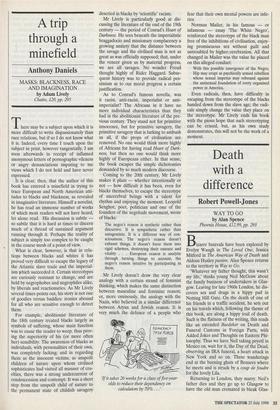Death with a difference
Robert Powell-Jones
WAY TO GO by Alan Spence
Phoenix House, £12.99, pp. 293 Bizarre funerals have been explored by Evelyn Waugh in The Loved One, Jessica Mitford in The American Way of Death and Aldous Huxley passim. Alan Spence returns to the territory in Way to Go.
'Whatever my father thought, this wasn't my life,' thinks young Neil McGraw about the family business of undertakers in Glas- gow. Leaving for late 1960s London, he dis- covers sex and drugs in a hippy pad in Notting Hill Gate. On the death of one of his friends in a traffic accident, he sets out on his travels which, following the theme of this book, are along a hippy trail of death. Such is the flatness of the writing, this reads . like an extended Baedeker on Death and Funeral Customs in Foreign Parts, with Added Jokes and Thoughts on Eastern Phi- losophy. Thus we have Neil taking peyotl in Mexico on, wait for it, the Day of the Dead, observing an IRA funeral, a heart attack in New York and so on. These wanderings end at the burning ghats of Benares where he meets and is struck by a coup de foudre for the lovely Lila.
Returning to London, they marry. Neil's father dies and they go up to Glasgow to have the old man cremated in bleak Glas- gow manner. Neil is drawn into taking on the businesses, on the footing that he 'could make it something different, some- thing new'. Scattering his father's ashes in Kelvingrove Park, he hits on a new slogan for the business, 'Way to Go'. He will offer 'funeral as theatre'. This is a perfectly rea- sonable idea, if not a new one, but there seems to be some confusion between what is unusual and what is theatrical. A conven- tional funeral is theatrical precisely because of its observance of conventions. There are few things more conventional or more theatrical, or more moving, than the wail of the pipes at a Highland funeral.
Inspired by contemporary Ghanaian carved coffins in the shape of a Mercedes of a rich man or at least one who wanted to be thought so, and so on, Neil's friend Des sets out to make speciality coffins. We then have quite a catalogue of -these: the Starship Enterprise, the football boot, the embalmed Hell's Angel bolted to a replica bike and, in an act of revenge by an alcoholic's widow, the whisky bottle. Neil meanwhile is occupied with differing forms of burial; in the back garden, in the com- post heap, from an aeroplane. The aim of all this, while mercifully undoctrinaire, is not entirely clear. There is a venture into the art world and a brush with a corporate rival.
In the last and best chapter of this novel, matters move closer to home as Neil finds some answer to his perennial question — what happens to you when you die?



























































 Previous page
Previous page